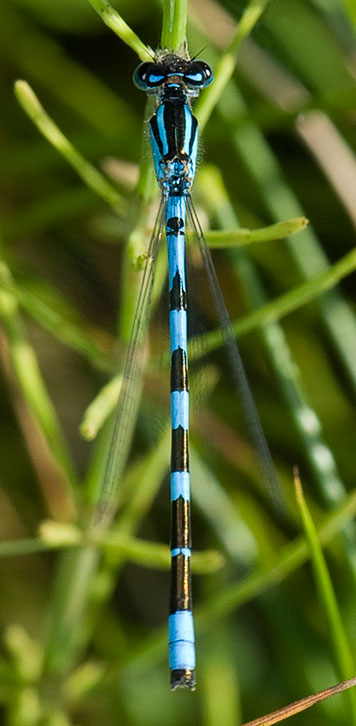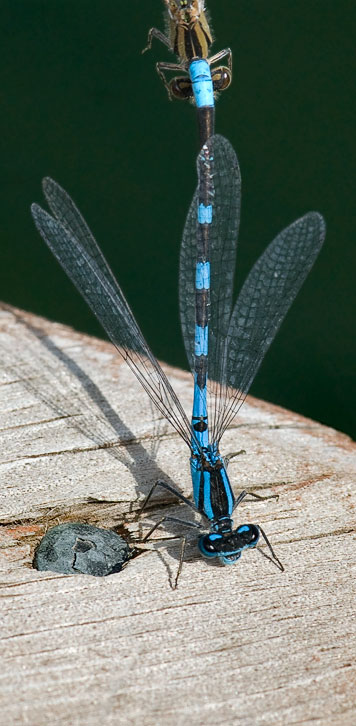Damselflies
Dragonfly or Damselfly Both groups have a very long abdomen, two pairs of wings and both are predators. Dragonflies are large and have a stout build; damselflies of smaller and have a slight build. The eyes of the dragonfly usually touch in the centre, the damselfly’s are separate. The damselfly usually rests with its wings along its body, the dragonfly with its wings spread to either side.
On a warm summer’s day, the water’s edge is populated with damselflies hunting, mating, and laying eggs. The damselfly is a predator which consumes flies, mosquitoes, and other small insects.
There are about two dozen different species of damselflies in British Columbia, but I don’t know how many of these can be seen around the Lake. So far, I have only seen one: (what I think is) the Tule Bluet (Enallagma carunculatum). Mind you, it has variations: while the male is blue and black, the female is usually yellowish and black, and the juvenile lacks colour. I am still waiting to see my second species.
This material is under development. The species identification should be considered tentative.
 This is a bluet, a common damselfly in BC. This is probably a Tule Bluet: it favours both the open lakeshores and marshes around the Lake.
This is a bluet, a common damselfly in BC. This is probably a Tule Bluet: it favours both the open lakeshores and marshes around the Lake.
 While many bluets have a blue and black abdomen, the Tule Bluet is distinctive in showing more black than blue on the middle abdomen segments.
While many bluets have a blue and black abdomen, the Tule Bluet is distinctive in showing more black than blue on the middle abdomen segments.
 When the adult emerges from the larval stage it initially lacks colouring and is said to be immature, or a juvenile.
When the adult emerges from the larval stage it initially lacks colouring and is said to be immature, or a juvenile.
 This immature damselfly appears to have the same banding as the Tule Bluet, but the clear regions have yet to gain colour.
This immature damselfly appears to have the same banding as the Tule Bluet, but the clear regions have yet to gain colour.
 Late August is the time to watch damselflies along the shore. Most of them are preoccupied with finding a mate.
Late August is the time to watch damselflies along the shore. Most of them are preoccupied with finding a mate.
 Prior to mating the male uses his claspers to hold the female by the back of the neck. If she is interested, she brings the end of her abdomen around to the base of his (see below). The female’s colour is varable, but usually brownish or yellowish.
Prior to mating the male uses his claspers to hold the female by the back of the neck. If she is interested, she brings the end of her abdomen around to the base of his (see below). The female’s colour is varable, but usually brownish or yellowish.
 This pair of bluets are mating. They are in the wheel position: the (blue) male clasps the (yellowish) female by the back of the neck. The female arches her abdomen up to receive the sperm.
This pair of bluets are mating. They are in the wheel position: the (blue) male clasps the (yellowish) female by the back of the neck. The female arches her abdomen up to receive the sperm.
Information from Living Landscapes: The Dragonflies of the Columbia Basin (includes damselflies).
![]()